
Concept explainers
Consider the following mRNA sequence:
- What amino acid sequence is coded for by this mRNA?
- What is the amino acid sequence ¡f a mutation converts ACC to ACU?
- What is the amino acid sequence if a mutation converts UUA to UCA?
- What is the amino acid sequence if a mutation converts CGA to AGA?
- What occurs if C is added to the beginning of the chain?
(a)
Interpretation:
Peptide synthesized by the 5' ACC UUA CGA 3' mRNA should be identified.
Concept Introduction:
DNA and RNA transform genetic information of the living cells through triplet code, which is a sequence of three nucleotides on DNA or RNA molecules codes for a specific amino acid in protein synthesis.
Answer to Problem 22.76P
Peptide − Thr-Leu-Arg
Explanation of Solution
Codons are written from 5 prime end (5) to 3 prime end (3) of mRNA. There is a unique triplet representation for a particular amino acid. Below mentioned table represent the relationship between nucleotides and amino acids.
The Genetic Code- Triplets in Messenger RNA
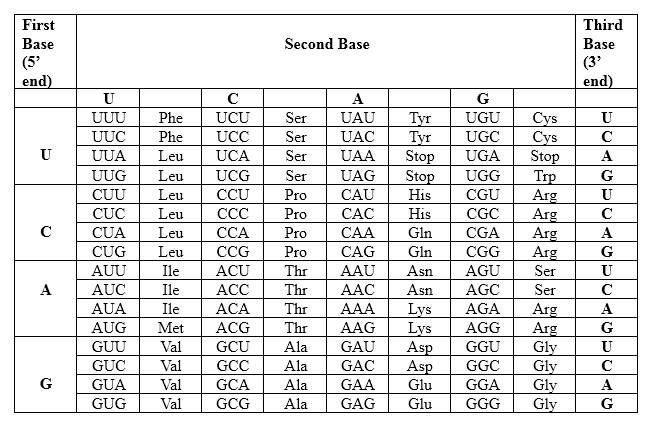
According to the above table; one amino acid has several triplets, but triplet code is unique for amino acid. ACC triplet is unique for Threonine. UUA triplet is unique for Leucine. CGA triplet is unique for Arginine.
Therefore, Thr-Leu-Arg is the amino acid sequence for 5' ACC UUA CGA 3'.
(b)
Interpretation:
Peptide formed from mutated mRNA5' ACU UUA CGA3' should be identified.
Concept Introduction:
DNA and RNA transform genetic information of the living cells through triplet code, which is a sequence of three nucleotides on DNA or RNA molecules codes for a specific amino acid in protein synthesis.
Mutation is an alteration of a sequence of nucleotides in DNA. Mutations can be classified based on the change that results in a DNA molecule.
Answer to Problem 22.76P
Peptide − Thr-Leu-Arg
Explanation of Solution
Mutation is an alteration of a sequence of nucleotides in DNA. When mutation happens at a particular position of a DNA molecule, that mutation goes through mRNA and translate a wrong peptide.
Mutations can be classified based on the change that results in a DNA molecule. There are three types of mutations which can be classified as follows;
- Point mutations − A substitution of one nucleotide for another nucleotide.
- Deletion mutations − One or more nucleotides is lost from a particular DNA molecule.
- Insertion mutations − One or more nucleotides is added to a DNA molecule.
Codons are written from 5 prime end (5') to 3 prime end (3') of mRNA. There is a specific sequence of nucleotides for each amino acid. Below mentioned table represent the relationship between nucleotides and amino acids.
The Genetic Code- Triplets in Messenger RNA
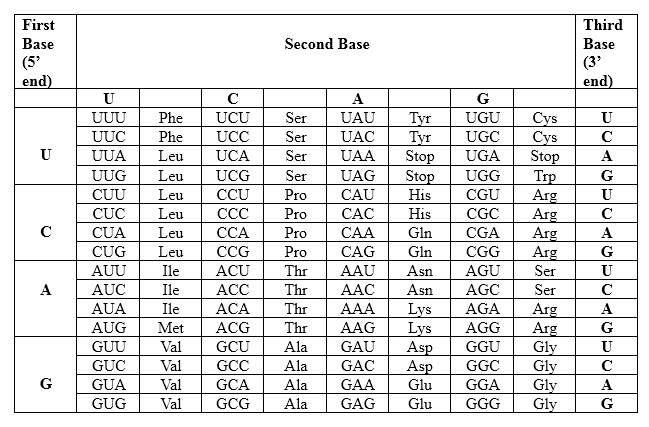
According to the above table; one amino acid has several triplets, but triplet code is unique for amino acid. ACU triplet is unique for Threonine. UUA triplet is unique for Leucine. CGA triplet is unique for Arginine. Though there is a point mutation in the mRNA strand, in this example same peptide is generated as the non-mutated peptide. Therefore; this mutation has no effect with the generating peptide.
Therefore, Thr-Leu-Arg is the amino acid sequence for 5' ACU UUA CGA 3'.
(c)
Interpretation:
Peptide formed from mutated mRNA 5' ACC UCA CGA 3' should be identified.
Concept Introduction:
DNA and RNA transform genetic information of the living cells through triplet code, which is a sequence of three nucleotides on DNA or RNA molecules codes for a specific amino acid in protein synthesis.
Mutation is an alteration of a sequence of nucleotides in DNA. Mutations can be classified based on the change that results in a DNA molecule.
Answer to Problem 22.76P
Peptide − Thr-Ser-Arg.
Explanation of Solution
Mutation is an alteration of a sequence of nucleotides in DNA. When mutation happens at a particular position of a DNA molecule, that mutation goes through mRNA and translate a wrong peptide.
Mutations can be classified based on the change that results in a DNA molecule. There are three types of mutations which can be classified as follows;
- Point mutations − A substitution of one nucleotide for another nucleotide.
- Deletion mutations − One or more nucleotides is lost from a particular DNA molecule.
- Insertion mutations − One or more nucleotides is added to a DNA molecule.
Codons are written from 5 prime end (5') to 3 prime end (3') of mRNA. There is a specific sequence of nucleotides for each amino acid. Below mentioned table represent the relationship between nucleotides and amino acids.
The Genetic Code- Triplets in Messenger RNA
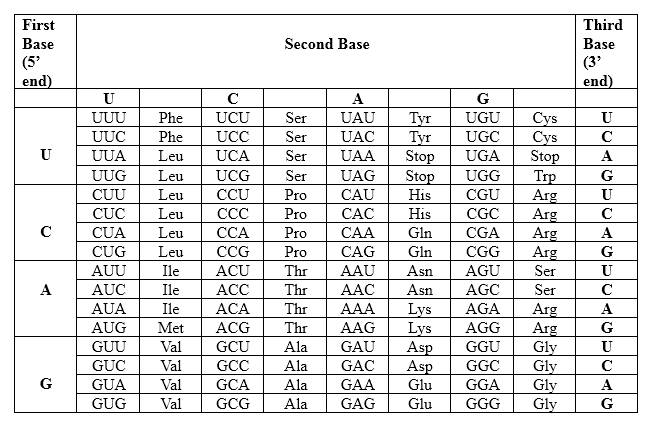
According to the above table; one amino acid has several triplets, but triplet code is unique for amino acid. ACC triplet is unique for Threonine. UCA triplet is unique for Serine. CGA triplet is unique for Arginine. There is a point mutation in the mRNA strand, which UUA in the normal strand converts to UCA in the mutated strand. The resulting protein is different from the un-mutated one.
Therefore, Thr-Ser-Arg is the amino acid sequence for 5' ACC UCA CGA 3'.
(d)
Interpretation:
Peptide formed from mutated mRNA 5' ACC UCA CGA 3' should be identified.
Concept Introduction:
DNA and RNA transform genetic information of the living cells through triplet code, which is a sequence of three nucleotides on DNA or RNA molecules codes for a specific amino acid in protein synthesis.
Mutation is an alteration of a sequence of nucleotides in DNA. Mutations can be classified based on the change that results in a DNA molecule.
Answer to Problem 22.76P
Peptide − Thr-Leu-Arg
Explanation of Solution
Mutation is an alteration of a sequence of nucleotides in DNA. When mutation happens at a particular position of a DNA molecule, that mutation goes through mRNA and translate a wrong peptide.
Mutations can be classified based on the change that results in a DNA molecule. There are three types of mutations which can be classified as follows;
- Point mutations − A substitution of one nucleotide for another nucleotide.
- Deletion mutations − One or more nucleotides is lost from a particular DNA molecule.
- Insertion mutations − One or more nucleotides is added to a DNA molecule.
Codons are written from 5 prime end (5') to 3 prime end (3') of mRNA. There is a specific sequence of nucleotides for each amino acid. Below mentioned table represent the relationship between nucleotides and amino acids.
The Genetic Code- Triplets in Messenger RNA
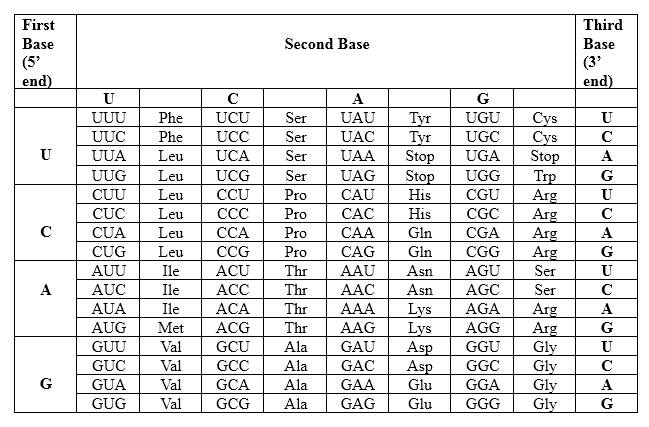
According to the above table; one amino acid has several triplets, but triplet code is unique for amino acid. ACC triplet is unique for Threonine. UUA triplet is unique for Leucine. AGA triplet is unique for Arginine. There is a point mutation in the mRNA strand, which CGA in the normal strand converts to AGA in the mutated strand. Though there is a point mutation in the mRNA strand, in this example same peptide is generated as the non-mutated peptide. Therefore; this mutation has no effect with the generating peptide.
Therefore, Thr-Leu-Arg is the amino acid sequence for 5' ACC UUA AGA 3'.
(e)
Interpretation:
Peptide formed from mutated mRNA 5' CACC UUA CGA 3' should be identified.
Concept Introduction:
DNA and RNA transform genetic information of the living cells through triplet code, which is a sequence of three nucleotides on DNA or RNA molecules codes for a specific amino acid in protein synthesis.
Mutation is an alteration of a sequence of nucleotides in DNA. Mutations can be classified based on the change that results in a DNA molecule.
Answer to Problem 22.76P
Peptide − His-Leu-Thr
Explanation of Solution
Mutation is an alteration of a sequence of nucleotides in DNA. When mutation happens at a particular position of a DNA molecule, that mutation goes through mRNA and translate a wrong peptide.
Mutations can be classified based on the change that results in a DNA molecule. There are three types of mutations which can be classified as follows;
- Point mutations − A substitution of one nucleotide for another nucleotide.
- Deletion mutations − One or more nucleotides is lost from a particular DNA molecule.
- Insertion mutations − One or more nucleotides is added to a DNA molecule.
Codons are written from 5 prime end (5') to 3 prime end (3') of mRNA. There is a specific sequence of nucleotides for each amino acid. Below mentioned table represent the relationship between nucleotides and amino acids.
The Genetic Code- Triplets in Messenger RNA
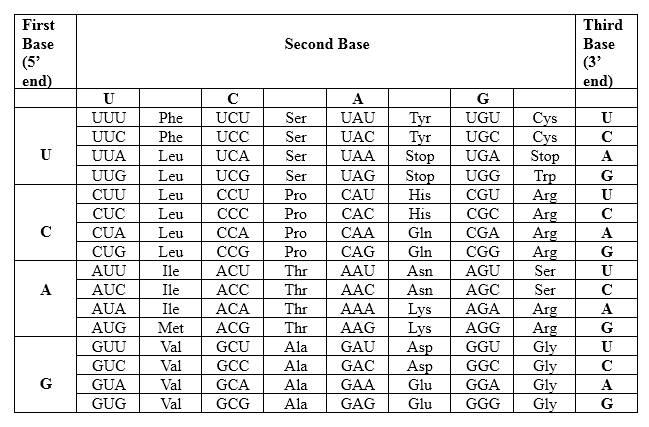
According to the above table; one amino acid has several triplets, but triplet code is unique for amino acid. Codons are written from 5 prime end (5') to 3 prime end (3') of mRNA and read as triplets, because of the insertion mutation which occurred here because of additional C in the beginning of the mRNA, triplets are read as follows. CAC triplet is for Histidine, CUU is for Leucine and ACG is for Threonine. Furthermore, there is an additional A nucleotide, which is not involved into this peptide. This mutation generates totally different peptide and generated peptide is as follows; His-Leu-Thr is the amino acid sequence for 5' CAC CUU A AG A 3'.
Want to see more full solutions like this?
Chapter 22 Solutions
EBK GENERAL, ORGANIC, & BIOLOGICAL CHEM
- Predict the product and write the mechanism. CH3-CH=CH-CH2-CH3 + NBS- hv CCl4arrow_forwardHow exactly is carbon disulfide used in industry? Specifically, where does it come in during rubber or textile production and what is the chemical processes?arrow_forwardA researcher has developed a new analytical method to determine the percent by mass iron in solids. To test the new method, the researcher purchases a standard reference material sample that is 2.85% iron by mass. Analysis of the iron standard with the new method returns values of 2.75%, 2.89%, 2.77%, 2.81%, and 2.87%. Does the new method produce a result that is significantly different from the standard value at the 95% confidence level?arrow_forward
- Create a drawing of an aceral with at least 2 isopropoxy groups, and a total of 11 carbon atomsarrow_forward4. Predict the major product(s) for each of the following reactions. HBr (1 equiv.) peroxide, A a. b. NBS, peroxide, Aarrow_forwardIn addition to the separation techniques used in this lab (magnetism, evaporation, and filtering), there are other commonly used separation techniques. Some of these techniques are:Distillation – this process is used to separate components that have significantly different boiling points. The solution is heated and the lower boiling point substance is vaporized first. The vapor can be collected and condensed and the component recovered as a pure liquid. If the temperature of the mixture is then raised, the next higher boiling component will come off and be collected. Eventually only non-volatile components will be left in the original solution.Centrifugation – a centrifuge will separate mixtures based on their mass. The mixture is placed in a centrifuge tube which is then spun at a high speed. Heavier components will settle at the bottom of the tube while lighter components will be at the top. This is the technique used to separate red blood cells from blood plasma.Sieving – this is…arrow_forward
- Nonearrow_forwardman Campus Depa (a) Draw the three products (constitutional isomers) obtained when 2-methyl-3-hexene reacts with water and a trace of H2SO4. Hint: one product forms as the result of a 1,2-hydride shift. (1.5 pts) This is the acid-catalyzed alkene hydration reaction.arrow_forwardNonearrow_forward
 General, Organic, and Biological ChemistryChemistryISBN:9781285853918Author:H. Stephen StokerPublisher:Cengage Learning
General, Organic, and Biological ChemistryChemistryISBN:9781285853918Author:H. Stephen StokerPublisher:Cengage Learning Organic And Biological ChemistryChemistryISBN:9781305081079Author:STOKER, H. Stephen (howard Stephen)Publisher:Cengage Learning,
Organic And Biological ChemistryChemistryISBN:9781305081079Author:STOKER, H. Stephen (howard Stephen)Publisher:Cengage Learning,
 Chemistry for Today: General, Organic, and Bioche...ChemistryISBN:9781305960060Author:Spencer L. Seager, Michael R. Slabaugh, Maren S. HansenPublisher:Cengage LearningChemistry: Matter and ChangeChemistryISBN:9780078746376Author:Dinah Zike, Laurel Dingrando, Nicholas Hainen, Cheryl WistromPublisher:Glencoe/McGraw-Hill School Pub Co
Chemistry for Today: General, Organic, and Bioche...ChemistryISBN:9781305960060Author:Spencer L. Seager, Michael R. Slabaugh, Maren S. HansenPublisher:Cengage LearningChemistry: Matter and ChangeChemistryISBN:9780078746376Author:Dinah Zike, Laurel Dingrando, Nicholas Hainen, Cheryl WistromPublisher:Glencoe/McGraw-Hill School Pub Co Chemistry & Chemical ReactivityChemistryISBN:9781337399074Author:John C. Kotz, Paul M. Treichel, John Townsend, David TreichelPublisher:Cengage Learning
Chemistry & Chemical ReactivityChemistryISBN:9781337399074Author:John C. Kotz, Paul M. Treichel, John Townsend, David TreichelPublisher:Cengage Learning





